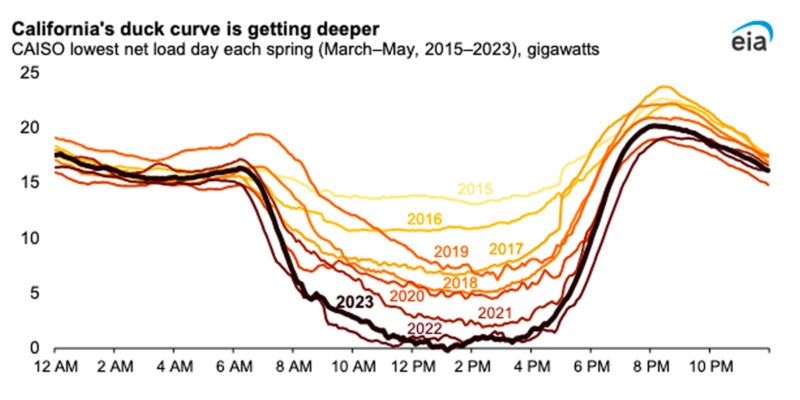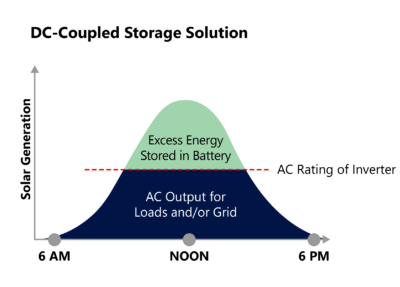Sign up for daily news updates from CleanTechnica on email. Or follow us on Google News!
 Balancing extreme swings in supply and demand of electricity has become a huge challenge for utility companies. Net Electricity demand plummets when solar production is at its peak. Then net demand spikes in the evening when solar is unavailable. To incentivize customers to change their energy habits, utilities are now offering TOU (Time of Use) billing plans to reflect hourly, daily and seasonal fluctuations in electricity supply and demand. This means consumers pay a higher rate at times when demand is high, typically between 4PM to 9PM, and a lower rate when demand drops and power is more prevalent from about 7PM to 4PM. The rate structures of these plans can be very complicated especially for inexperienced consumers. To fully maximize their savings, they need to analyze daily and hourly data and make complex energy decisions with financial consequences.
Balancing extreme swings in supply and demand of electricity has become a huge challenge for utility companies. Net Electricity demand plummets when solar production is at its peak. Then net demand spikes in the evening when solar is unavailable. To incentivize customers to change their energy habits, utilities are now offering TOU (Time of Use) billing plans to reflect hourly, daily and seasonal fluctuations in electricity supply and demand. This means consumers pay a higher rate at times when demand is high, typically between 4PM to 9PM, and a lower rate when demand drops and power is more prevalent from about 7PM to 4PM. The rate structures of these plans can be very complicated especially for inexperienced consumers. To fully maximize their savings, they need to analyze daily and hourly data and make complex energy decisions with financial consequences.
Evolving Electricity Marketplace
Homes are consuming a lot more electricity, as energy-hungry devices like EVs and heat pumps grow in popularity. In 2022 U.S. heat pump purchases exceeded those of gas furnaces, and approximately 5.7% of U.S. car sales were fully electric. For a typical household with at least two electric vehicles, charging could account for 60-70% of the home’s annual consumption. Depending on the commute, a single EV can double a household’s monthly electricity bill, while two EVs can triple it.
The “Duck Curve” Effect
With abundant renewable energy in the grid, balancing extreme variances in electricity supply and demand throughout the day has become a major challenge for electricity retailers and grid operators. This challenge is expressed in the “Duck Curve” coined in 2012 by the California Independent System Operator. At midday when solar production peaks, the net load (forecasted load on the grid after subtracting electricity production from renewables)—plummets. In spring and summer the curves create a “belly” appearance, sinking lower each year as solar export increases.

Timing imbalance between solar generation and peak demand in “California’s Duck curve” effect deepening from 2015-2023; source: CAISO
After sundown when solar production stops and people come home from work, the net load spikes, producing the “duck’s neck”. This steep ascent requires operators to dispatch resources to quickly ramp up production, reflected in rising electricity rates.
Moving forward, to power everything with solar, consumers need the ability to store energy during the day and use it later at night, avoiding high peak evening rates.
New Energy Billing Structures
With these market dynamics, California and other successful solar markets are encouraging consumers to change their habits. They are now offering new variable-rate billing contracts to reflect changing feed-in policies and to address energy needs and usage patterns. These plans are aimed at reducing compensation for exported solar energy and incentivizing solar storage solutions. While each state may tackle the issue somewhat differently, essentially, they’re all trying to shift consumption to off-peak periods and reduce grid import at peak hours.
Fixed rate plans: Fixed rate, or single rate plans—the traditional way of billing for electricity—are based on a flat rate per each kWh of energy either bought from or exported to the grid. Consumers don’t need to consider peak or off-peak hours, as rates are all the same. These plans typically offer peace of mind, knowing exactly how much one will pay per kWh consumed or exported. To incentivize consumers to change their behavior some utility companies are offering newer types of billing contracts to replace fixed rate plans.
Time of Use (TOU) plans: TOU plans are a new type of energy plan being introduced by utilities. They include preset energy prices for different times throughout the day, generally including an evening on-peak period, overnight off-peak hours, and two “shoulder” periods in between.
In TOU plans rates are usually higher in the early evening during peak demand and lower at off-peak. This gives customers the option of buying cheap electricity at certain hours, like at night when demand for electricity drops. Consumers can increase their savings at these off-peak times, by pre-scheduling EV charging and other heavy loads, or by charging solar batteries from the grid—for later use when prices go up the following morning.
In Arizona, some utilities are offering demand-charge based plans to incentivize consumers to change their consumption habits. These plans set higher rates for weekdays between 4-7pm (peak hours), to get people to use less energy and manage their consumption during these hours.
To alleviate stress on the grid especially during sharp spikes in demand, like on summer afternoons when hundreds of thousands of Arizonians crank up their AC, there’s an additional ‘demand charge’ on top of each kWh of electricity purchased. This ‘penalty’ applies to the highest level of electricity a consumer demands (like for running heavy load appliances) during on-peak hours. This demand charge is calculated using the highest average rate in the billing period.
The Impact of NEM 3.0 regulations
In recent years we’ve seen California take the lead in the transition to sustainable living in the U.S. The Golden State experienced a massive increase in solar installations following its net energy metering (NEM) 2.0 regulations which offered attractive incentives to homeowners investing in solar.
In April 2023 the new NEM 3.0 regulations (Net Billing Tariff or NBT) were implemented, including import rates structured like TOU plans with specific rate schedules tied to time of day, day of the week and month. To discourage export during the day when solar is plentiful, a separate set of export rates were defined, also varying by time, day and month.
This new time-based energy pricing was the first time California implemented extreme price signaling that influences consumer behavior to such a degree. Under NBT there are periods when solar generation yields zero value. But, during high demand customers exporting to the grid are offered exceptionally high rates, reaching even $3/kWh—10 times more than average rates. This could effectively provide enough energy during extreme heat waves and reduce power outages.
With these new TOU rates, it can be more profitable for homeowners to sell energy and more expensive to buy it. They simply need to consider the best time to export. California, once a net metering market, is now shifting to a self-consumption based one. Under these conditions, where it’s more cost-effective to store your energy for personal use after sundown, solar with storage becomes highly advantageous.
Sounds complicated to navigate in this new environment? You’re not alone.
Too Many Decisions, Data Too Complex to Process
For the average household generating its own electricity, fully maximizing savings in TOU and NBT markets can be quite complex. It requires tracking vast energy-related data and making daily decisions. Naturally, it’s best to use stored solar in the evening when rates are higher. But when and how much energy should be stored? When is it profitable to buy grid power? A wrong decision or no decision at all could be costly.
Older energy management methods for maximizing self-consumption are no longer sufficient or economically viable.
Managing and Optimizing Rate Plans with SolarEdge Home*
SolarEdge is a leading global supplier of residential solar energy systems. Its smart energy ecosystem, SolarEdge Home, is designed to automatically manage the home’s power in real time, to maximize energy production and optimize savings 24/7.
SolarEdge Home adapts to each household’s rate plan, making hundreds of daily decisions based on internal and external data, as well as homeowner preferences. Analyzing utility rates, home appliances, weather forecasts, solar production and consumption patterns, it generates a daily energy plan. This plan optimizes energy usage and maximizes financial savings, determining the most profitable times to buy, sell and consume energy.
Leveraging over 3 million global installations to develop sophisticated prediction algorithms, SolarEdge Home uses powerful cloud analytics and machine learning to estimate how much solar will be generated over a given period. Simultaneously, other algorithms calculate when and how much energy the household will consume throughout the day.
*Pending firmware upgrade
Using Batteries in a New Way for Time-of-Use
With many homeowners now considering storage, SolarEdge recently introduced SolarEdge ‘Rate Saver’. This storage-only solution lowers battery system costs for homeowners by up to 38%** by reducing equipment and installation costs and the need for potential main panel upgrades. A DC-coupled solution, SolarEdge ‘Rate Saver’ enables clipped energy—solar energy produced beyond the inverter’s rating capacity—to be captured and stored directly in the battery. This energy is otherwise lost in AC-coupled systems. To provide maximum energy storage efficiency ‘Rate Saver also eliminates the multiple power conversions in AC-coupled systems.

Image courtesy SolarEdge
Investing in a solar and storage solution is beneficial for TOU plans. Californians exporting to the grid receive 5 cents/kWh on average. In September these export rates jump to almost $3/kWh from 6-8 PM, and homeowners closely managing their energy system could potentially get sizable compensation for exporting surplus solar.
But with NEM 3.0’s export rates differing from hour to hour it can be difficult to calculate potential revenues from selling solar to the grid. Here’s where product selection is key. To maximize profitability for homeowners, the best systems use algorithms to ensure the battery is automatically charged before peak times and fully discharged during the peak hour “window.”
Load shifting is another way to increase solar energy self-consumption. Scheduling energy-hungry appliances like dishwashers, dryers, and EV chargers to run during highest solar production times helps customers save more by using much more of the energy they produce. To meet the growing need for energy, as demand for home EV-charging increases, load shifting is becoming essential. SolarEdge automates this process and calculates the best time to charge or use the battery, offering a major advantage for homeowners under NEM 3.0.
SolarEdge’s fully integrated solution with a DC-coupled battery and advanced predictive algorithms is poised to optimize different rate plans to benefit consumers everywhere. It can provide higher energy yield for the home, and potentially a faster return on investment for homeowners through greater TOU savings and load shifting.
**Per SolarEdge testing and evaluation

Image courtesy SolarEdge.
Chris Thompson, Vice President of Product and Technical Marketing at SolarEdge
Chris has over 30 years of diversified global expertise in power electronics, power and solar energy systems for utility-scale and residential markets. Since 2020 Chris has led SolarEdge’s Grid Services, Technical Marketing and Regulatory functions in North America.
He held senior management positions at international energy management and automation enterprises, leading different global business units for grid power, advanced power conversion, UPS, battery backup & renewable energy storage, and datacenter power distribution. He also led venture capital investments in solar, battery technology, fuel cells and autonomous devices.
Chris holds bachelor’s degrees with highest honors in both Mechanical and Electrical engineering from Tufts University, an MBA in Marketing and Finance from the University of Chicago, and a master’s degree in electrical engineering from the National University of Singapore where he served as a Fulbright Scholar. https://www.linkedin.com/in/solarchris/
This article is sponsored by SolarEdge.
Have a tip for CleanTechnica? Want to advertise? Want to suggest a guest for our CleanTech Talk podcast? Contact us here.
EV Obsession Daily!
I don’t like paywalls. You don’t like paywalls. Who likes paywalls? Here at CleanTechnica, we implemented a limited paywall for a while, but it always felt wrong — and it was always tough to decide what we should put behind there. In theory, your most exclusive and best content goes behind a paywall. But then fewer people read it!! So, we’ve decided to completely nix paywalls here at CleanTechnica. But…
Thank you!
Tesla Sales in 2023, 2024, and 2030
CleanTechnica uses affiliate links. See our policy here.




